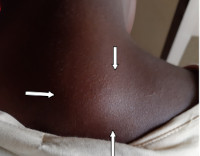Giant Hypertrophy of the Fifth Cervical Spinous Process with associated Hemivertebra presenting as Posterior Neck Mass
DOI:
https://doi.org/10.60787/tnhj.v23i4.756Keywords:
Spine, cervical spine, computed tomography, hypertrophy of the spinous processAbstract
Congenital anomalies of the spine are relatively common and can affect both upper and lower limbs. However, hypertrophy of the spinous process is an extremely rare anomaly of the cervical spine, and many anomalies of the cervical spines are commonly encountered which include persisting apophyses of the transverse processes, persisting epiphyses, vertebral platyspondylia, vertebral hypoplasia, and dysplasia of the arch of the vertebra. The majority of these vertebral abnormalities are often incidental findings in radiography with few causing pain, and aesthetic problems to the patients. Thus, we present a 12-year-old female who presented to the paediatric outpatient clinic on account of swelling at the lower back of her neck of 4 years duration, and recurrent neck pain of one-month duration. The patient noticed the mass 4- years prior to presentation, as a painless, slow-growing lump behind her neck which appears more prominent whenever she flexes her neck. The USS revealed a linear hyperechogenicity within the hypoechoic soft tissue (muscle) of the posterior neck and a plain radiograph of the neck was subsequently obtained and showed abnormal elongation with downward curvature of the spinous process of the sixth cervical vertebra. A diagnosis of giant hypertrophy of the fifth cervical vertebra spinous process with hemivertebra at C6 was made. The was managed conservatively with satisfactory outcomes.
Downloads
References
Farooqi RM, Mehmood M, Kotwal HA. Hyperplasia of Lamina and Spinous Process of C5 Vertebrae and Associated Hemivertebra at C4 Level. J. Orth. Case Reports. 2017;7(1):79-81.
Klimo P Jr, Rao G, Brockmeyer D. Congenital anomalies of the cervical spine. Neurosurg Clin N Am. 2007; 18: 463-478.
Beals RK, Robbins JR, Rolfe B. Anomalies associated with vertebral malformations. 1993: (18): 1329-1332.
Basu PS, Elsebaie H, Noordeen MH. Congenital spinal deformity: a comprehensive assessment at presentation. Spine.2002; 27:2255-2259.
Heyer CM, Nicolas V, Peters SA. Unilateral hyperplasis of a cervical spinous process as a rare congenital variant of the spine. Clin Imaging. 2007; 31(6):343-346.
Esposito G, de Bonis P, Tamburrini G, Massimi L, Byvaltsev V, Di Rocco CD, et al. Unilateral hyperplasia of the left posterior arch and associated vertebral schisis at C6 level. Skeletal Radiol 2009;38(12):1191-1195
Moghaddam AM, Tanriöver N, Ulu MO, Muhammedrezai S, Akar Z. Cervical intradural lipoma with associated hemivertebra formation at C6 level: A case report. Turk Neurosurg 2008;18(2):187-190.
Mesut ME, Ữnsal ỮỮ, Duranosoy YK, Umur AS, Selcuki M. A giant hypertrophy of C5 spinous process in Klippel- Feil syndrome. J neurol Sci (Turkish). 2015; 32(3):575-579
Reddy OJ, Gafoor JA, Suresh B, Lakshmi KC. A case report of giant C5 spinous process with partial vertebrae fusion at C2, C3, and C4 levels. J NTR Univ Health Sci. 2017; 6: 129-132.
Atalar H, Yavuz OY, Doğruel H, Catal SA, Sayli U. Phalanx-like osseous structure posterior to the cervical vertebrae: a hitherto unreported location for a rare anomaly. Acta Orthop Traumatol Turc. 2005;39(4):361–364.
Rashid M, Khalid M, Malik N. Sacral rib: a rare congenital anomaly. Acta Orthop Belg. 2008;74(3):429–431
Ishikawa E, Matsumura A, Enomoto T, Tsurubuchi T, Nose T. Ectopic fingerlike structure in the thoracic region: case report. J Neurosurg Spine. 2001; 95:250–252.

Published
Issue
Section
License
Copyright (c) 2023 Journal and Publisher

This work is licensed under a Creative Commons Attribution-NonCommercial-NoDerivatives 4.0 International License.
The Journal is owned, published and copyrighted by the Nigerian Medical Association, River state Branch. The copyright of papers published are vested in the journal and the publisher. In line with our open access policy and the Creative Commons Attribution License policy authors are allowed to share their work with an acknowledgement of the work's authorship and initial publication in this journal.
This is an open access journal which means that all content is freely available without charge to the user or his/her institution. Users are allowed to read, download, copy, distribute, print, search, or link to the full texts of the articles in this journal without asking prior permission from the publisher or the author.
The use of general descriptive names, trade names, trademarks, and so forth in this publication, even if not specifically identified, does not imply that these names are not protected by the relevant laws and regulations. While the advice and information in this journal are believed to be true and accurate on the date of its going to press, neither the authors, the editors, nor the publisher can accept any legal responsibility for any errors or omissions that may be made. The publisher makes no warranty, express or implied, with respect to the material contained herein.
TNHJ also supports open access archiving of articles published in the journal after three months of publication. Authors are permitted and encouraged to post their work online (e.g, in institutional repositories or on their website) within the stated period, as it can lead to productive exchanges, as well as earlier and greater citation of published work (See The Effect of Open Access). All requests for permission for open access archiving outside this period should be sent to the editor via email to editor@tnhjph.com.





